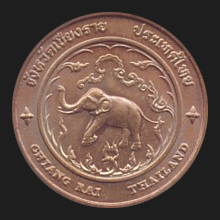|
Chiang Rai (เชียงราย)
Thai. Name of a
province and
its provincial capital (map)
in North Thailand. The city lies on the southern bank of the Kok River
(fig.), at 829 kilometers
north of
Bangkok and 185 kms from
Chiang Mai, and at an altitude of around 416 meters above
sea level. It has a population of approximately 45,000 inhabitants.
In northern dialect it is called Chiang Hai. The city was founded in
1262 by King
Mengrai as part of the
Lan Na kingdom. Chiang Rai became Thai territory in 1786
and a Thai province in 1910. Among the
places of interest
are the
King Mengrai Monument (map
-
fig.),
Wat Rong Khun
(fig.),
Wat
Tham
Pla
(map
-
fig.),
several natural hot
springs, e.g. those at Wiang Pa Pao (map
-
fig.), the City Clock Tower (fig.),
Wat Rong Seua Ten
(fig.),
Wat Khrua Khrae (fig.),
Wat Ming Meuang (fig.),
Khun Kon National Forest Park
and
Waterfall (fig.),
Wat Phra Kaew
(fig.), and
Wat Tham
Pah Acha Thong
with its
phra khi mah bintabaat,
as well as the city's most important
historical monument,
Wat Phra Kaew. In this temple the
Emerald Buddha
was discovered after its octagonal
chedi
was struck and
damaged by lightning in 1434 thus revealing the statue. The province
covers an area of 11,678 kmsē and numbers around 1,225,000
inhabitants. Its northern border is formed by the
Mae Khong
river, with across the provinces Bokeo and Oudomxai of the
Democratic Republic of
Laos, whilst to the West it borders
the
Shan
State of the Union of
Myanmar at the
Golden Triangle, once the hub of
opium
production. Furthermore it borders
the Thai provinces of
Phayao,
Lampang
and Chiang Mai and is the most northerly
province, about 2,100 kms away from Thailand's southernmost border.
Its northernmost town is Mae Sai, situated at the confluence of the
Ruak and Mae Sai rivers, at the Burmese border. The province has 16
amphur and two
king amphur, 124
tambon and 1,510 villages known as
mu ban.
See also
Chiang Rai data file.
回






|

